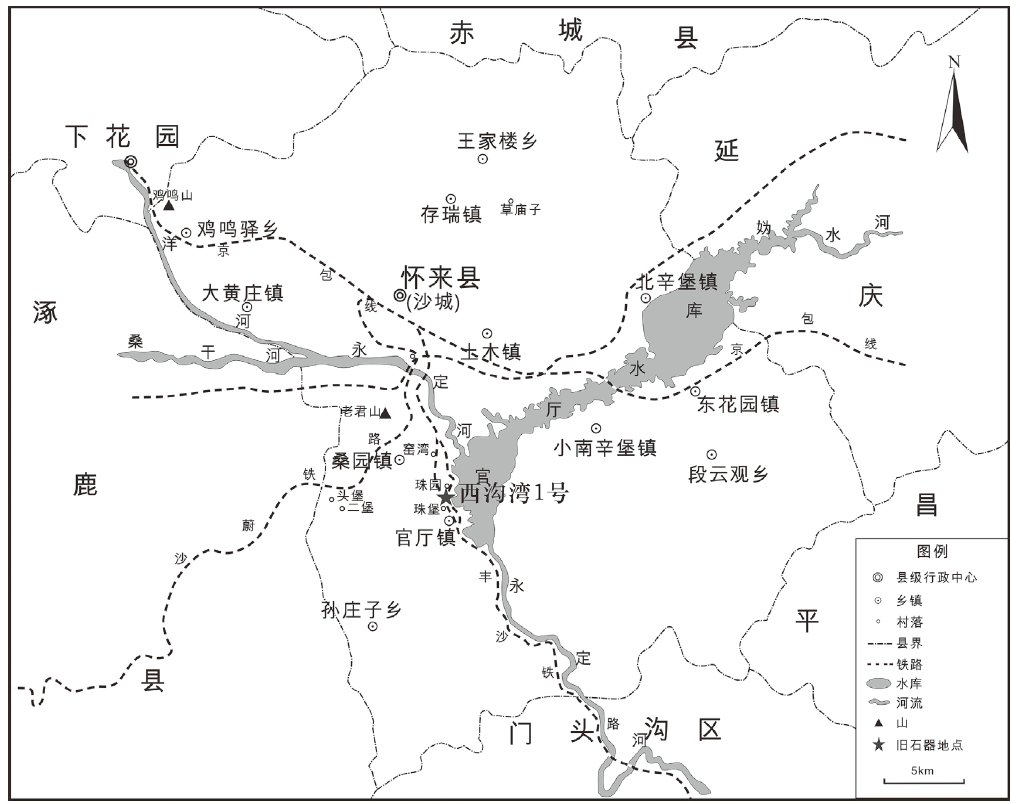

The excavation of the Xigouwan Paleolithic Locality 1 in Huailai Basin
Received date: 2018-04-03
Revised date: 2018-05-23
Online published: 2020-09-10
The Xigouwan Paleolithic Locality 1(XGW1) is situated in Zhuwoyuan village, Guanting town, Huailai county of Hebei Province. The Paleolithic remains are mainly buried in the second terrace of the right bank of the Yongding River. This Paleolithic locality was excavated from August to September, 2015. The excavation exposed an area of 27 m2, and 232 stone artifacts and 19 mammalian fossils were unearthed. Most mammalian fossils consist of burned bones that cannot be identified because of their small size. Although there was no hearth found, many charcoal chips and burned bones unearthed still indicate the use of fire.The lithic assemblage of XGW1 includes cores (n=8; 3.4%), flakes (n=141; 60.8%), chunks (n=68; 29.3%), a hammerstone (n=1; 0.4%) and pebbles (n=14; 6.1%), but there were no retouched pieces found. The general features of these artifacts can be summarized as follows:a) Raw materials for stone knapping are mainly trachyte, accounting for 97.8%, and there is only a small amount of trachyandensite and andesite. Comparative study shows that the local raw materials should have been exploited.b) On the whole, most stone artifacts are small in size, and the micro and medium-sized pieces only account for a certain amount, and large specimens are very few.c) The principle flaking technique was direct hard hammer percussion. Although there are only 8 cores, the overall reduction of these cores is relatively high according to the number of platforms and flaked surfaces, the proportion of remaining cortex, and the platform angles. Most complete flakes were produced from non-cortical platforms, and the relatively high percentage (60%) of type III and VI flakes indicates that many whole flakes represent continuous flaking of the core.The typological and technological characteristics of stone artifacts show that they belong to a flake tool technological system. It can be inferred from the excavation and the analysis of the stone assemblage that XGW1 is most likely a short-term factory site. The AMS Carbon-14 dating results show that XGW1 can be dated to the late Paleolithic (Cal 41997-41186 BP).Located in the northeast of the Nihewan basin, the Huailai basin is an important area and channel for human migration and technological communication during the Pleistocene. However, for a long time, only a few scholars have organized for several Paleolithic archaeological surveys in Huailai basin. Fewer archaeological excavations have been conducted, and so far there have been no related archaeological excavation reports published. The Xigouwan Paleolithic locality 1 is not only an important part of the “Grand Nihewan” archaeology, but the report on its excavation also provides valuable information for the study on technological development and communication, human migration and adaptation in the Yongding river drainage area.

Feng XUE , Yuni XIAO , Yuting LENG , Dingyuan LI , Yanhao LI , Dongwei NIU . The excavation of the Xigouwan Paleolithic Locality 1 in Huailai Basin[J]. Acta Anthropologica Sinica, 2019 , 38(02) : 212 -222 . DOI: 10.16359/j.cnki.cn11-1963/q.2018.0032
| [1] | 牛东伟, 薛峰, 李鼎元, 等. 怀来盆地2014年度旧石器考古调查简报[J]. 人类学学报, 2018,37(1):79-87 |
| [2] | 杨景春. 怀来盆地的形成、发展、古河道演变与新构造运动的关系[J].中国第四纪研究, 1965(2):93-104 |
| [3] | 高振西. 怀来盆地的生成与喜马拉雅期造山运动[J].地质知识, 1954(2):31-32 |
| [4] | 袁宝印, 孙建中, 刘坛森. 延怀盆地第四纪地层及地文期[A].见: 泥河湾研究论文选 [C].文物出版社, 1989, 475-488 |
| [5] | 尹金辉, 计凤桔, 郑荣章, 等. 永定河上游晚更新世晚期以来的堆积阶地年代测定[J]. 地震地质, 2000(2):195-199 |
| [6] | 邓皓匀, 吴胜和. 永定河沉积特征研究[J]. 地质与资源, 2013,22(2):142-147 |
| [7] | 李容全. 黄河、永定河发育历史与流域新生代古湖演变间的相互关系[J].北京师范大学学报:自然科学版, 1988(4):84-93 |
| [8] | 卫奇. 《西侯度》石制品之浅见[J]. 人类学学报, 2000,19(2):85-96 |
| [9] | Toth N. The oldowan reassessed: A close look at early stone artifacts[J]. Journal of Archaeological Science, 1985,12(2):101-120 |
| [10] | Cooper JR, Qiu F. Expediting and standardizing stone artifact refitting using a computerized suitability model[J]. Journal of Archaeological Science, 2006,33(7):987-998 |
| [11] | 谢飞. 泥河湾旧石器文化[M].花山文艺出版社 |
| [12] | 谢飞.泥河湾的科学意义[N]. 2012 -12-05 |
| [13] | 谢飞.河北旧石器时代晚期细石器遗存的分布及在华北马蹄形分布带中的位置[J].文物春秋, 2000(2): 15-25/29 |
/
| 〈 |
|
〉 |